|
Jan
17
2023
|
|
Posted 2 years 331 days ago ago by Admin
|
|

Rotorcraft Pro rebranded itself as Rotor Pro, as we expanded our coverage beyond manned helicopters to include eVTOLs and UAVs. In line with this change, the scope of this year’s ‘Best of’ article has been expanded as well, which is why we’re calling it ‘Best of Rotor Tech 2022'. Here are some of the highlights of the year that’s just passed
Archer Aviation Unveils ‘Midnight’ eVTOL
Archer Aviation’s 12-engine (six for forward motion, six for vertical lift) five-person eVTOL called “Midnight” continues its march towards commercial operations in the next three years. Beyond a scheduled unveiling to the public on 16 November 2022 at a company open house in San Jose, California, Midnight is currently in an FAA certification process that Archer hopes to complete in 2024. The aircraft is targeted at the urban air mobility market, to provide an option to overloaded ground transportation systems.
.jpg?ver=e41-wbJvOIglfldtpViyqA%3d%3d)
“Midnight is expected to be able to carry over 1,000 pounds of payload, making it a true pilot-plus-four-passenger aircraft, which is key to enabling our revenue models,” said Samuel Swanson, Archer Aviation spokesperson. “Midnight is expected to be able to fly up to 100 miles, but more importantly, it is expected to be able to complete our target mission of successive 20-mile flights with a charging time in-between of approximately 10 minutes”
Archer’s work on the production version of Midnight is being guided by “Maker,” the company’s demonstration eVTOL. According to Swanson, “Archer’s engineers continue to make huge advancements, both throughout the design, development, and flight testing of Maker, our full-scale demonstrator aircraft, and during the ongoing design and development of Midnight.”
At press time, this company is in the process of shifting its flight-test focus from Maker to a pre-production prototype of Midnight. “We expect to make significant progress in Midnight's developmental flight testing program throughout 2023 and anticipate completion in-time to achieve FAA certification by late-2024, with commercial business operations scheduled to begin in 2025,” Swanson said.
Airbus Shapes Future Tech with Flightlab and RACER
Over the last few months, Airbus Helicopters has been performing in-flight tests onboard its Flightlab, a platform-agnostic flying laboratory exclusively dedicated to maturing new technologies. Flightlab’s purpose is to efficiently test technologies that could later benefit current helicopter models, as well as innovate new technology for future platforms like AAM (Advanced Air Mobility) and eVTOL. “Our DNA at Airbus is about innovation to bring value to our customers,” said Romain Trapp, President of Airbus Helicopters, North America.
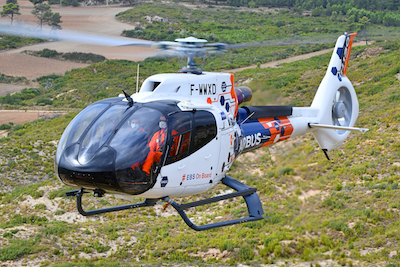
One of the main focus areas for Flightlab has been the development and testing of the EBS (Engine Back-up System) which utilizes an electric motor connected to the main gearbox, which can provide electrical power for 30 seconds in the event of engine failure. By giving the pilot extra time to react and maintain rotor speed, the engine back-up system contributes to a safer and smoother autorotation maneuver to the ground.
Additionally, there’s been an effort to develop the next generation of flight control systems. “Right now we are in the process of testing a new flight control system with a double objective. On one side we want to further reduce pilot workload during sensitive flight phases, such as close to the ground. On the other side, we desire to simplify the human-machine interface with system commands similar to fly-by-wire,” said Trapp.
Airbus Helicopters has also utilized Flightlab to pursue the testing of hybrid and electric propulsion technologies, as well as exploring autonomy, and other technologies aimed at reducing helicopter sound levels or improving maintenance and flight safety.
If it’s speed you are seeking, look no further than the Airbus Rapid and Cost-efficient Rotorcraft (RACER). Last year Airbus began assembling the RACER demonstrator with the intention of first flight in 2023.
The helicopter was funded through a European government grant worth $227 million (200 million euros) called Clean Sky 2 which was a research initiative involving 13 European countries, 40 companies, and university partners.
The lightweight and fast civilian aircraft can be leveraged for many missions:
• Search and rescue
• Commercial transportation
• Public service
• And emergency medical support
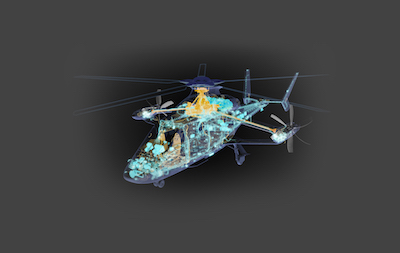
Thanks to the innovative Safran Eco-Mode hybrid-electrical system, which allows one of the two engines to be switched to stand by while in cruise, RACER will use 15% less fuel per nautical mile at 180 kts (normally 130 kts). Assembly began in Germany with a metallic and composite airframe with the main structure being made from additive manufacturing.
The assembly, being completed in Marignane, is nearing completion with the engines ready to be installed as of this writing.
“We are very excited about RACER as it’s basically a brand new helicopter that will soon perform its first flight. The “electrical power on” tests will take place before the end of this year,” said Trapp.
Canadian UAVs Pioneers BVLOS Flights, DAA Radar
UAV services provider and technology development company Canadian UAVs scored a major success in 2022 when Transport Canada (Canada’s regulatory agency) granted the company a nationwide special flight operations certificate (SFOC) to operate its fleet of remotely piloted aircraft systems (RPAS) beyond visual line of sight (BVLOS) – a major advance in the deployment of commercial UAV services. This first-of-its-kind-in-Canada certificate allows Canadian UAVs to perform BVLOS flight operations anywhere in Canada in Class G airspace, up to 400 feet AGL (above ground level).

Canadian UAVs was able to obtain the certificate due to its Sparrowhawk DAA (detect and avoid) radar system that has also been approved by Transport Canada. The Sparrowhawk DAA system uses low-cost, ground-based radars that are tuned for manned aircraft detection and radar modeling software to support safe BVLOS UAV flight operations. The long-range, all-weather Sparrowhawk system integrates seamlessly with any RPAS operating platform, without anything having to be installed on the actual UAV. It can be deployed as either a fixed or mobile installation. “In 2023, Canadian UAVs will introduce new features to Sparrowhawk as well as increase the operating range of the system,” said Canadian UAVs Senior Systems Engineer Robert Gustavsson.
Jaunt Air Mobility Advances Flight Tech
During 2022, Jaunt Air Mobility continued the development of its fixed-wing/rotor eVTOL aircraft, which is being developed for numerous markets such as urban passenger and cargo transport, corporate, EMS, and law enforcement operations. The all-electric Jaunt multi-passenger eVTOL uses a fixed-wing platform with four forward-facing propellers and a larger horizontal main rotor to achieve flight.
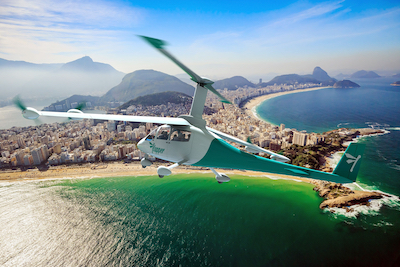
“Jaunt has progressed the slowed rotor compound (SRC) technology used to minimize rotor noise and maximize aircraft performance by modulating the rotor rpm and blade loading through a sophisticated algorithm that accounts for ambient conditions, altitude, and airspeed of the aircraft,” said Martin Peryea, senior vice president and general manager of Electric Air Mobility at Jaunt Air Mobility owner, AIRO Group Holdings. He added, “In addition to optimizing aircraft performance and noise, the SRC system calculates and maintains the required rotor inertial energy required to complete a safe autorotative landing upon a complete loss of propulsive power from any given altitude and speed.”
The need to create quiet and safe eVTOLs for operations in and around city centers is an absolute must. “Urban air mobility (UAM) will not be successful without addressing affordability, convenience, and public acceptance,” Peryea said
Joby Aviation Closes in on FAA Certification
Joby Aviation made significant progress in 2022 towards certifying its six-engine eVTOL aircraft. “We signed a revised Stage 4, G-1 certification basis with the FAA,” said Katie Pribyl, company spokesperson. “We have nearly 75% of our means of compliance accepted under the new framework and the FAA has now accepted three of our ASCPs (aviation system capacity plans) for area-specific certification plans. Almost all of the remaining 25% has been submitted to the FAA for review and approval.”
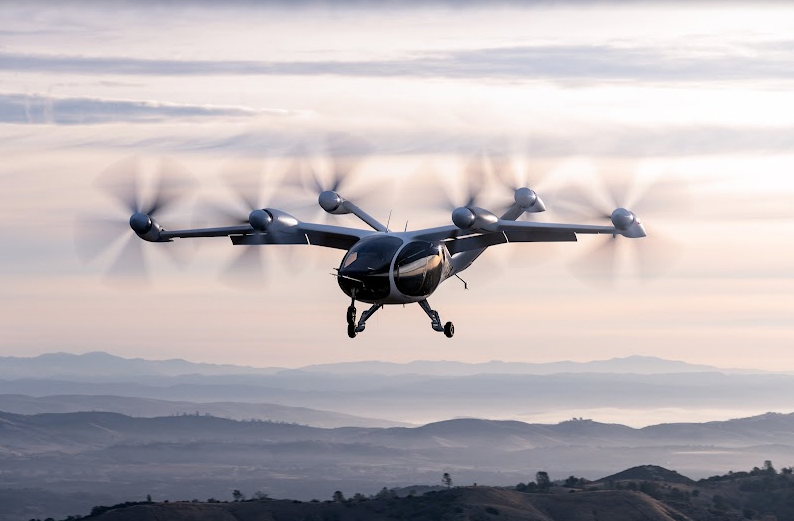
During the same time period, Joby collaborated with NASA to demonstrate its eVTOL’s low noise profile. “Noise is one of the main reasons helicopters are kept out of cities today,” Pribyl explained. “We will be 100 times quieter: This will allow regular flights in and out of cities without adding to the background noise, meaning we can get people closer to their destination and offer compelling service.”
Joby Aviation has also increased its aircraft supply contract with the U.S. Department of Defense to more than $75 million, due to the U.S. Marine Corps joining the Air Force as potential Joby aviators.
“We remain laser-focussed on our three key goals of (a) achieving certification, (b) scaling pilot manufacturing and (c) preparing for commercial operations,” said Pribyl. “Our engagement with the DoD provides a low risk route to early operations before achieving a type certification. Joby is relatively unique in the eVTOL sector in having a dual path to operations through the government and consumer sectors.”
Leonardo Helicopters Upgrades Helicopter Tailplanes, AW169 Avionics
Leonardo Helicopters told Rotor Pro about two main innovations it is working on. The first is Leonardo’s ORIGAMI project. According to a company spokesperson, ORIGAMI is a helicopter tailplane design that employs aerodynamic tips to improve performance at both high and low speeds, while significantly increasing stability. “Designed as a retrofit kit, it aims to replace conventional tips and, at the same time, preserve the main body of the tailplane,” the spokesperson said. “A key element of the design is that the new concept may be applied to several helicopters, avoiding a complete redesign of the tailplane.” The ORIGAMI upgrade has received EASA certification, and is now part of the model AW169 standard configuration together with an airflow deflector added on the right side of the tail boom.
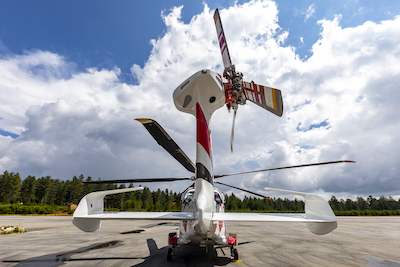
The second innovation is the latest AW169 Phase 7/8 core avionics software release and performance increase package, boosting this helicopter’s engine shaft horsepower. “All of those certified upgrades provide increased payload in several operational conditions such as in hot-and-high and sea level scenarios, delivering greater performance and making the AW169 the helicopter model with the best power-to-weight ratio in its class,” the spokesperson said.
NHV Completes First Sustainable Fuel Flight
This past October, helicopter operator NHV successfully executed its first sustainable aviation fuel (SAF) flight in collaboration with partner TotalEnergies. The NHV helicopter left the company’s Ostend base and flew to Elia’s modular offshore grid (MOG 1), a platform in the North Sea that brings together cables from offshore wind farms and connects them to the mainland.
The SAF biofuel supplied by TotalEnergies is made from recyclable waste, such as used cooking oils. On this flight, the use of sustainable aviation fuel produced by TotalEnergies reduced CO2 emissions by 27%.
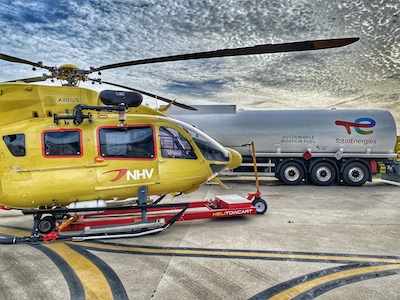
“This is a huge milestone for NHV and the industry because it’s the first time sustainable aviation fuel is used to support offshore wind,” said Bram De Backer, NHV Group’s vice president of offshore wind. “Investing in this kind of fuel is the first step in reducing the overall carbon footprint and making helicopter transportation more environmentally friendly.”
Textron eAviation Prioritizes Nexus eVTOL
The eVTOL Nexus Program has been transferred from Bell to Textron eAviation, following the creation of this business unit in the fall of 2021. This unit is putting its efforts into the Nexus eVTOL. About 50 full-time engineers are working in Wichita, Kansas, on building the first flying Nexus prototype. A first flight of this prototype is targeted in the next couple of years.
According to information provided to Rotor Pro by Textron eAviation, the Nexus is intended to be a multipurpose eVTOL aircraft. It will be optimized for passenger transport (four passengers and pilot) and can be adapted for cargo, EMS, and other missions.
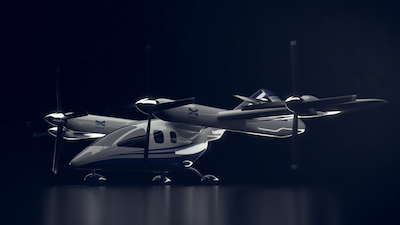
“The current Nexus design is an open rotor, fully electric distributed propulsion system with four tilting rotors and two stationary vertical lifters,” the Textron eAviation submission stated. To ensure it complies with current published FAA vertiport regulations, it will be 42 feet long and will include a 50-foot wingspan. It is projected to be about the size of a Cessna Caravan.
The Nexus eVTOL aircraft design is targeting a range of up to 100 nautical miles with a cruise speed of 120 knots. It will have a useful payload of 800 pounds and a gross weight of 8,000 pounds. “This proposed weight and configuration is representative of a pragmatic approach to design, which includes a complex battery system and the rigor associated with certification,” said the submission. “The Nexus will produce zero carbon emissions by use of all-electric distributed propulsion.”
READ MORE ROTOR PRO NOV/DEC ISSUE
READ MORE ROTOR PRO: https://justhelicopters.com/Magazine
WATCH ROTOR PRO YOUTUBE CHANNEL: https://buff.ly/3Md0T3y
You can also find us on
Instagram - https://www.instagram.com/rotorpro1
Facebook - https://www.facebook.com/rotorpro1
Twitter - https://twitter.com/justhelicopters
LinkedIn - https://www.linkedin.com/company/rotorpro1